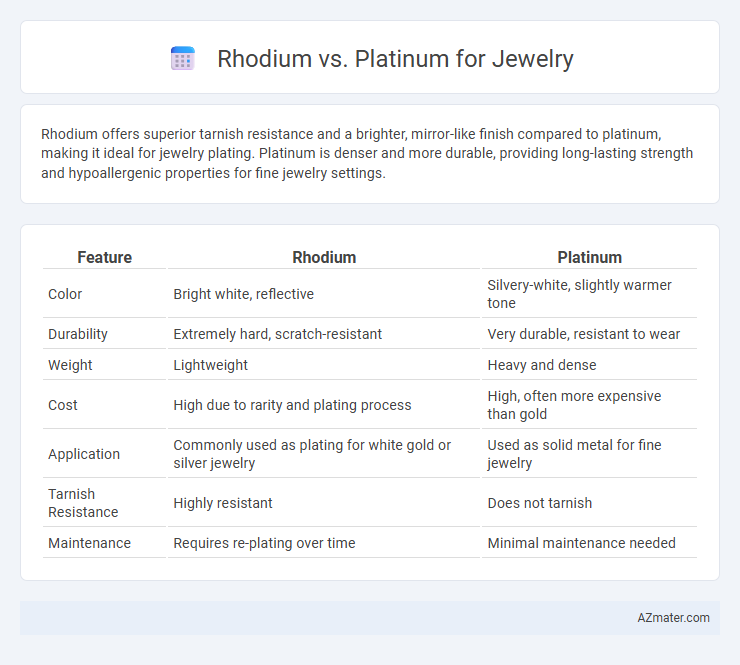Rhodium offers superior tarnish resistance and a brighter, mirror-like finish compared to platinum, making it ideal for jewelry plating. Platinum is denser and more durable, providing long-lasting strength and hypoallergenic properties for fine jewelry settings.
Table of Comparison
| Feature | Rhodium | Platinum |
|---|---|---|
| Color | Bright white, reflective | Silvery-white, slightly warmer tone |
| Durability | Extremely hard, scratch-resistant | Very durable, resistant to wear |
| Weight | Lightweight | Heavy and dense |
| Cost | High due to rarity and plating process | High, often more expensive than gold |
| Application | Commonly used as plating for white gold or silver jewelry | Used as solid metal for fine jewelry |
| Tarnish Resistance | Highly resistant | Does not tarnish |
| Maintenance | Requires re-plating over time | Minimal maintenance needed |
Introduction to Rhodium and Platinum in Jewelry
Rhodium and platinum are both precious metals highly valued in jewelry for their durability, luster, and resistance to tarnish. Rhodium, a rare member of the platinum group metals, is commonly used as a plating material to enhance the brightness and scratch resistance of white gold and silver jewelry. Platinum, with a naturally white sheen and exceptional density, is prized for its hypoallergenic properties and ability to maintain its shine over time without requiring plating.
Chemical Properties and Composition
Rhodium, a member of the platinum group metals with atomic number 45, exhibits exceptional corrosion resistance and a high melting point of 1964degC, making it ideal for durable jewelry coatings. Platinum, atomic number 78, is denser and more malleable, with a melting point of 1768degC and a naturally white luster that resists tarnishing due to its inert chemical properties. Both metals are chemically stable and resistant to oxidation, but rhodium's higher hardness and reflectivity make it the preferred choice for plating platinum or other jewelry to enhance durability and shine.
Durability and Longevity
Rhodium and platinum differ significantly in durability and longevity for jewelry applications. Platinum is a naturally durable metal known for its resistance to tarnish, scratches, and wear, making it ideal for everyday wear and heirloom pieces. Rhodium, often used as a plating over white gold or silver, provides a bright, reflective finish but tends to wear off over time, requiring periodic re-plating to maintain its appearance and protection.
Appearance and Finish
Rhodium offers a bright, reflective white finish that enhances the brilliance of jewelry, making it appear more lustrous and resistant to tarnish compared to platinum's naturally white but slightly grayer hue. Rhodium plating is commonly applied to white gold and silver pieces to provide a sleek, mirror-like surface that maintains its shine for longer periods. In contrast, platinum possesses a naturally durable and dense finish that develops a unique patina over time, valued for its subtle matte look and superb scratch resistance.
Hypoallergenic Qualities
Rhodium and platinum are both popular choices for hypoallergenic jewelry due to their low reactivity and resistance to tarnish. Platinum is a naturally hypoallergenic metal, making it ideal for sensitive skin, while rhodium is often used as a plating material on jewelry to provide a smooth, non-allergenic surface. Both metals reduce the risk of allergic reactions, but platinum's pure form generally offers better long-term hypoallergenic benefits compared to rhodium plating.
Cost Comparison
Rhodium plating is significantly more affordable than solid platinum jewelry, with rhodium primarily used as a thin, reflective coating over silver or white gold to enhance appearance and durability at a lower cost. Platinum's price is considerably higher due to its rarity, density, and use as a solid precious metal, often costing three to four times more per gram than rhodium plating applications. Maintenance and durability factors also influence cost over time, as rhodium plating requires periodic reapplication to prevent wear, while platinum's inherent hardness minimizes frequent repairs.
Common Jewelry Applications
Rhodium, prized for its brilliant white finish and high reflectivity, is commonly used as a plating material to enhance the appearance and durability of white gold and silver jewelry. Platinum, a dense and durable metal, is favored for creating entire pieces such as engagement rings, wedding bands, and luxury watches due to its natural tarnish resistance and hypoallergenic properties. Both metals excel in fine jewelry applications, with rhodium primarily serving as a protective coating and platinum valued for its substantial and long-lasting form.
Maintenance and Care Requirements
Rhodium plating on jewelry requires regular maintenance to preserve its bright, reflective finish, typically needing reapplication every 6 to 12 months due to natural wear and exposure. Platinum jewelry is more durable and scratch-resistant, demanding less frequent upkeep but benefits from occasional professional polishing to maintain its luster. Both metals are hypoallergenic, yet rhodium's plating can wear off on high-contact pieces, while solid platinum remains consistently durable with minimal care.
Environmental and Ethical Considerations
Rhodium and platinum differ significantly in environmental and ethical considerations within jewelry production. Rhodium, often sourced as a byproduct of platinum and nickel mining, has benefits in reducing additional mining impact, yet its refining process is energy-intensive and environmentally taxing. Platinum mining typically involves higher environmental disruption and ethical concerns due to labor practices, though certification programs are advancing responsible sourcing to mitigate these issues.
Choosing Between Rhodium and Platinum
Choosing between rhodium and platinum for jewelry involves considering durability, appearance, and budget. Rhodium offers a brilliant, reflective finish often used as a plating for white gold or silver, providing excellent corrosion resistance but requiring periodic reapplication due to wear. Platinum is a naturally white, dense metal valued for its longevity, hypoallergenic properties, and higher price point, making it ideal for fine jewelry that maintains its appearance with minimal maintenance.

Infographic: Rhodium vs Platinum for Jewelry
 azmater.com
azmater.com